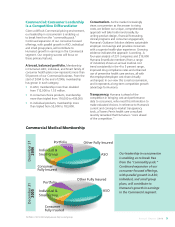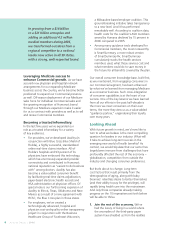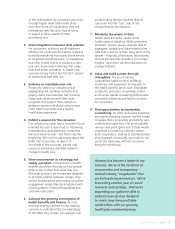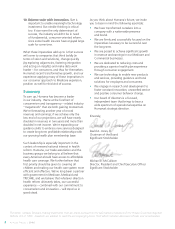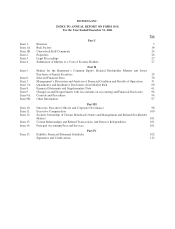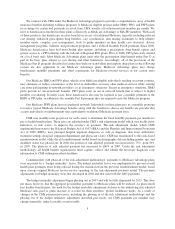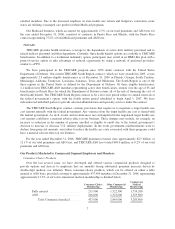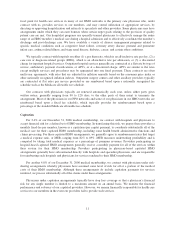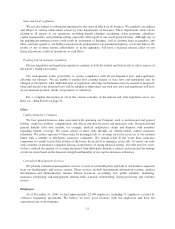Humana 2006 Annual Report Download - page 17
Download and view the complete annual report
Please find page 17 of the 2006 Humana annual report below. You can navigate through the pages in the report by either clicking on the pages listed below, or by using the keyword search tool below to find specific information within the annual report.We contract with CMS under the Medicare Advantage program to provide a comprehensive array of health
insurance benefits including wellness programs to Medicare eligible persons under HMO, PPO, and PFFS plans
in exchange for contractual payments received from CMS, usually a fixed payment per member per month. We
refer to beneficiaries enrolled in these plans collectively as Medicare Advantage or MA-PD members. With each
of these products, the beneficiary receives benefits in excess of traditional Medicare, typically including reduced
cost sharing, enhanced prescription drug benefits, care coordination, data mining techniques to help identify
member needs, complex case management, tools to guide members in their health care decisions, disease
management programs, wellness and prevention programs, and a reduced monthly Part B premium. Since 2006,
Medicare beneficiaries have had more health plan options, including a prescription drug benefit option and
greater access to a PPO offering with the roll-out of Regional PPO plans. Prior to 2006, PPO plans were offered
on a local basis only. Most Medicare Advantage plans must offer the prescription drug benefit under Part D as
part of the basic plan, subject to cost sharing and other limitations. Accordingly, all of the provisions of the
Medicare Part D program described in connection with our stand-alone prescription drug plans in the following
section are also applicable to our Medicare Advantage plans. Medicare Advantage plans may charge
beneficiaries monthly premiums and other copayments for Medicare-covered services or for certain extra
benefits.
Our Medicare HMO and PPO plans, which cover Medicare-eligible individuals residing in certain counties,
may eliminate or reduce coinsurance or the level of deductibles on many other medical services while seeking
care from participating in-network providers, or in emergency situations. Except in emergency situations, HMO
plans provide no out-of-network benefits. PPO plans carry an out-of network benefit that is subject to higher
member cost-sharing. In many cases, these beneficiaries also may be required to pay a monthly premium to the
HMO or PPO plan, in addition to the monthly Part B premium they are required to pay the Medicare program.
Our Medicare PFFS plans have no preferred network. Individuals in these plans pay us a monthly premium
to receive typical Medicare Advantage benefits along with the freedom to choose any health care provider that
accepts individuals at reimbursement rates equivalent to traditional Medicare payment rates.
CMS uses monthly rates per person for each county to determine the fixed monthly payments per member to
pay to health benefit plans. These rates are adjusted under CMS’s risk adjustment model which uses health status
indicators, or risk scores, to improve the accuracy of payment. The risk adjustment model, which CMS
implemented pursuant to the Balanced Budget Act of 1997 (BBA) and the Benefits and Improvement Protection
Act of 2000 (BIPA), uses principal hospital inpatient diagnoses as well as diagnosis data from ambulatory
treatment settings (hospital outpatient department and physician visits). CMS has transitioned to this risk-based
reimbursement model while the old reimbursement model based on demographic data including gender, age, and
disability status was phased out. In 2006, the portion of risk adjusted payment was increased to 75%, from 50%
in 2005. The phase-in of risk adjusted payment has increased to 100% in 2007. Under the risk adjustment
methodology, all health benefit organizations must capture, collect, and submit the necessary diagnosis code
information to CMS within prescribed deadlines.
Commensurate with phase-in of the risk-adjustment methodology, payments to Medicare Advantage plans
were increased by a “budget neutrality” factor. The budget neutrality factor was implemented to prevent overall
health plan payments from being reduced during the transition from the previous reimbursement model, based
upon average original Medicare fee-for-service spending, to the risk-adjustment payment model. The payment
adjustments for budget neutrality were first developed in 2002 and first used with the 2003 payments.
The budget neutrality adjustment began phasing out in 2007 and will be fully eliminated by 2011. This does
not mean, however, that the aggregate per-member payments to Medicare plans will be reduced. As plans enroll
less healthy beneficiaries, the need for the budget neutrality adjustment declines as the underlying risk adjusted
Medicare rates paid to plans increase to account for their enrollees’ greater healthcare needs. As a result of
changes in the CMS payment processes, including the phasing in of the risk adjustment methodology and the
phasing out of the budget neutrality adjustment described previously, our CMS payments per member may
change materially, either favorably or unfavorably.
5


